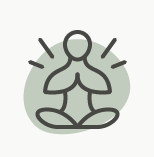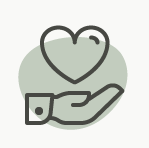
UMD Student Life recognizes that student wellbeing and student success go hand in hand. Our student wellbeing initiative supports our students holistically. We created a set of wellbeing dimensions, subdimensions, and facilitators and then mapped our work to each.
The Student Life Wellbeing and Wellness Index provides a way of tracking efforts that support the dimensions, subdimensions, and facilitators of student wellbeing. In this way, Student Life ensures that the work we do for and with students relates strongly to their wellbeing, development, and success. In addition, we are able to see changes over time and identify program and service gaps.
We got the idea from the Canadian Index of Wellbeing at the University of Waterloo.
Dimensions and Subdimensions
Student Life's dimensions and subdimensions of wellbeing and wellness are defined below. Indicators for each area are provided along with the abbreviations for departments that will provided data for each indicator. Data is entered for those items collected in a given year. Not every indicator is tracked every year, but over time data is collected on all indicators. A key for the abbreviations is found at the bottom of the page.
MIND

This dimension encompasses the importance of our intellectual, emotional, and spiritual wellbeing.
- Intellectual wellness embraces life-long learning by being intentional about what sparks our creativity and interest. Through intellectual wellness, we strive for an open mind to incorporate new concepts, information, and skills.
- Emotional wellness is realizing our own capacity to affirm ourselves and cope with daily stressors through acknowledging thoughts and feelings and implementing strategies to manage our lives in a healthy way.
- Spiritual wellness is a process of honoring the sacred within the natural world. Through spiritual wellness, we seek to understand, challenge, and strengthen individual beliefs, values, rituals, and ethics that guide and give meaning to our lives.
| Subdimensions | Indicators | 2021-2022 | 2022-2023 | |
|---|---|---|---|---|
| Intellect | Number of completed career assessments (CC) | 535 | 755 | |
| Number of student contacts with their Disability Specialist (DR) | 1,895 | 3,127 | ||
| Number of participants in tutoring and study session programs (ODI) | Average: 8/week | 240 | ||
| Number of events in designated celebrations (Black History Month, Consent Week, Domestic Violence Awareness Month, Trafficking Awareness Month, Women’s History Month) (Division-wide) | 128 | 61 | ||
| Number of learning/living community participants (HRL) | 160 | 107 | ||
| Number of students participating in leadership training (division-wide) | 270 | 595 | ||
| Number of students participating in conflict resolution options (formal resolutions, Bulldog Engagement Network, notice and coaching, conflict mediation) (OSCCR) | 156 | 134 | ||
| Completion rate for the EVERFI modules: AlcoholEdu and Sexual Misconduct Prevention (VCSL office) | AlcoholEdu - 81.1%, Sexual Misconduct Prevention - 84.4% | AlcoholEdu - 78.0%, Sexual Misconduct Prevention - 80.8% | ||
| Number of students enrolled in SSP and UST courses (AWLC) | ||||
| Emotion | Number of students participating in individual counseling sessions (HS) | 2,644 | 2,934 | |
| Number of students participating in Let’s Talk sessions (HS) | 62 | 44 | ||
| Number of caring interventions (HRL) | 566 | 526 | ||
| Number of students participating in conflict resolution options (formal resolutions, Bulldog Engagement Network, notice and coaching, conflict mediation) (OSCCR) | 156 | 134 | ||
| Number of student cases for the Student Care Team (VCSL office) | 221 | 203 | ||
| Spirit | Number of religious or faith-based student organizations (KSC) | 17 | 19 | |
| Number of students participating in conflict resolution options (formal resolutions, Bulldog Engagement Network, notice and coaching, conflict mediation) (OSCCR) | 156 | 134 |
PURPOSE

Purpose is applying one’s unique values, passions, and abilities to gain meaning and direction.
| Indicators | 2021-2022 | 2022-2023 | ||
|---|---|---|---|---|
| Number of participants in the Alumni Mentor Program (AR) | 102 | 87 | ||
| New Handshake registrants (CC) | 1,484 | 1,842 | ||
| Career Center individual appointments (CC) | 575 | 516 | ||
| Number of check-ins with students on probation (OSCCR) | 10 | 4 | ||
| Number of participants in the CORE program (ODI) | 420 | 1,067 |
BODY

Physical well-being includes lifestyle and behavioral patterns which are maintained over the course of time and are tailored to meet an individual’s goals and needs. These lifestyle and behavioral patterns help to ensure health, avoid preventable diseases and conditions, and to live in a balanced state of body, mind, and spirit.
| Indicators | 2021-2022 | 2022-2023 | ||
|---|---|---|---|---|
| Number of dietary consultations and food tours (DS) (DS) | 20 | 32 | ||
| Number of students visiting Champ’s Cupboard and Champ's Closet (VCSL) | 256 | 256 | ||
| Number of student medical appointments (HS) | 5,587 | 4921 | ||
| Number of health education presentations (HS) | 250 Health Ed Presentations, reaching 6, 699 attendees | 100 outreach presentations reaching 3,467 attendees | ||
| Number of Recreation Center accesses (RSOP) | 163,772 | 176,658 |
CONNECTEDNESS

This dimension encompasses the importance of our connectedness through community and culture.
- Based on a common experience or purpose, community wellbeing involves the wellness of both the individuals and the larger group. Community wellbeing builds healthy and supportive networks to cultivate belonging and general connectedness with others in the community, which in turn leads to a willingness to act together in mutually beneficial ways. Contributing to community facilitates safe access to spaces, opportunities for us to participate as our authentic selves, and promotes a shared culture of wellness.
- A culturally well person/individual is able to acknowledge their own culture, regardless of identity and experience, and the impacts their culture(s) have on others. Additionally, they are able to honor and celebrate the unique experiences that other backgrounds and identities bring to the community. Holistically, they are able to intertwine the experiences of self and others to positively contribute to the UMD community.
| Subdimensions | Indicators | 2021-2022 | 2022-2023 | |
|---|---|---|---|---|
| Community | Number of participants in the Alumni Relations Grad Party (AR) | 221 | 193 | |
| Student experiences in dining on campus (DS) | 44 | |||
| Number of participants in new student orientation events (KSC, ODI, HRL) | 2,150 (KSC), 27 (ODI), 1,971 (HRL) | 2100 (KSC), 41 (ODI), 64 (RSOP) | ||
| Number of participants in peer mentoring programs (ODI) | 10 | 18 | ||
| Number of Community Connection Events (HRL) | 832 | |||
| Number of student organizations (KSC) | 245 | 238 | ||
| Number of students using collaboration spaces and group study rooms (KAML) | ||||
| Sales of UMD spirit wear (UMD Stores) | $1,812,922 (annually), $151,077 (monthly) | $1,865,211 annually $155,434 per month | ||
| Culture | Number of student participants in immersive diversity training (Transgender Justice Teach-in, Call to Action, LINC) (division-wide) | 424 | 418 | |
| Number of students trained through the "Got Your Back, UMD!" bystander intervention program (HS) | 35 | 65 | ||
| Number of students employees participating in diversity, equity, and inclusion training programs (division-wide) | 603 | 321 | ||
| Number of Student Life student employees participating in diversity, equity, and inclusion training programs (division-wide) | 96 | 95 | ||
| Number of programs related to sexual assault prevention | 20 | 25 |
ENVIRONMENT

Environmental wellbeing is the way in which connection with our surroundings contributes to overall positive health, happiness and fulfillment. Making a deliberate effort to explore new environments with unknown variables in nature and in society helps a person develop new skills and learn from their successes and failures. With enhanced curiosity and courage to explore new environments the potential for lifelong learning, wellbeing and personal growth are infinite.
| Indicators | 2021-2022 | 2022-2023 | ||
|---|---|---|---|---|
| Monitoring of waste on campus (DS, Sustainability) | ||||
| Number of sustainability programs - (HRL) | 52 | |||
| Number of rides in the UPass program (TPS) | 147,521 | 145,570 | ||
| Number of Outdoor Program events offered (Outdoor activities, Climbing, Sea Kayaking, Kite/Surf/Stand-up Paddleboarding) (RSOP) | 227 | 376 | ||
| Total number of Outdoor Gear Rentals (RSOP) | 6,542 | 6,395 |
ECONOMIC

Economic wellbeing is defined as the state of having present and future financial security. It also includes the ability to make economic choices and feel a sense of security, satisfaction, and personal fulfillment with one's personal finances and employment pursuits. Economic wellbeing may be achieved through policies that ensure the ability to build financial knowledge and skills, access to safe and affordable products and economic resources, and opportunities for generating income and asset-building.
| Indicators | 2021-2022 | 2022-2023 | ||
|---|---|---|---|---|
| Number of student employees in Student Life (OBP) | 493 | 465 | ||
| Number of students receiving scholarships awarded by Student Life units (division-wide) | 108 | 99 | ||
| Number of participants in job and internship fairs (CC) | 850+ | 1,752 | ||
| Number of rides in the UPass program (TPS) | 147,521 | 145,570 | ||
| Number of Champ’s Cupboard and Champ's Closet users (VCSL) | 256 | 256 | ||
| Savings to students from textbook affordability initiatives (UMD Stores) | $288,506 | $375,369 |
Facilitators
Facilitators are foundational components that aid students in achieving and feeling a sense of wellness. The absence of these facilitators may prevent students from achieving and feeling a sense of wellness. Student Life's facilitators of wellbeing and wellness are defined below.
Access and Opportunity

Facilitators are the foundational components that aid students in achieving and feeling a sense of wellness. As a facilitator, access and opportunity provide:
- Meaningful access to programs and services
- Usability
- Variety of delivery methods
- Individually-defined achievements
Space and Resources

Facilitators are the foundational components that aid students in achieving and feeling a sense of wellness. As a facilitator, space and resources provide:
- Physical space
- Financial resources
- Time
- Mental Energy
Safety and Security

Facilitators are the foundational components that aid students in achieving and feeling a sense of wellness. As a facilitator, space and resources provide:
- A sense of feeling safe
- A sense of stability
- A sense of privacy of information
Helpful Information
Key to Abbreviations:

Source for wellness icons: Dribbble